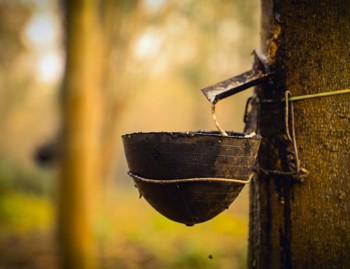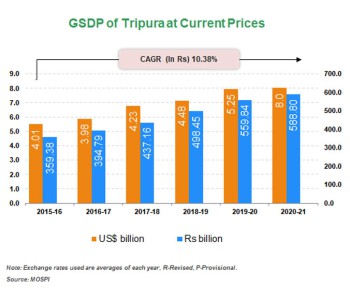INTRODUCTION
Tripura, one of the northeast states, share borders on the north, west, south, and southeast by Bangladesh, and in the east, it shares border with Assam and Mizoram.
The state has favourable climatic conditions for cultivation of various fruit and horticultural crops. It is rich in natural resources such as natural gas, rubber, tea, and medicinal plants.
The state is also rich in natural gas deposits, glass sands, limestone, plastic clay, and hard rock. With its pleasant climate and scenic landscape, Tripura is a favoured tourist destination. The state offers tourist attractions such as historical Hindu and Buddhist sites, temples, rivers, and rock carvings. In 2019, the number of foreign tourist arrivals in the state was recorded to be 154,405.
The state has favourable climatic conditions for cultivating various fruit and horticultural crops including rice, jackfruit, pineapple, potato, sugarcane, chilli, and natural rubber. Rice is the major crop of the state and is cultivated in 91% of the cropped area. The state has a wide variety of medical plants having 266 medicinal plants, 379 species of trees, 581 herbs, 320 shrubs and 165 climbers.
Tripura attracted Foreign Direct Investment (FDI) equity inflow worth US$ 0.43 million between October 2019 and March 2021 according to the data released by Department for Promotion of Industry and Internal Trade (DPIIT).
Tripura has 87.22% literacy rate, higher than the national average rate, making it an ideal destination for knowledge sectors.
As of April 2021, Tripura had a total installed power generation capacity of 723.96 MW, of which 153.01 MW was under state utilities, 566.54 MW was under central and 4.41 MW was under the private sector. Of the total installed capacity, 630.05 MW was contributed by thermal power, 68.49 MW by hydropower and 25.42 MW by renewable resources as of April 2021.
The state has a wide range of fiscal and policy incentives for businesses under the Tripura Industrial Investment Promotion Incentive Scheme, 2017. Developing infrastructure, improved rail and air connectivity, and establishment of trade routes have facilitated trade.



KEY SECTORS
- The agro-climatic conditions in the state are favourable for growing various fruits and horticultural crops. Tripura’s pineapples and oranges are known for their unique flavour and organic nature.
- As per the third advance estimate of 2019-20, the total fruit production in the state is 562.46 thousand MT, vegetables is 811.67 thousand MT, plantation is 50.39 thousand MT and spices is 33.15 thousand MT.
- Tripura has developed a horticulture action plan for 2020-21, with estimated capital outlay of Rs. 123.54 crore (US$177 million). The main objective of this annual plan is to increase the production and productivity of various horticulture crops in the state.
- Tripura has vast natural gas reserves. The gas is available in a non-associate form, with high methane content of about 97.0%. Concessional gas-pricing and vast reserves offer potential for setting up industries in the sector. Natural Gas production in Tripura stood at 1,378 million cubic metres (mcm) during 2019-20 (till February 2020).
- An agri-export zone for pineapples is also being developed. The state also has potential in the meat processing sector. Tripura implemented the National Food Security Act, 2013 in September 2015 and became the first state to implement the act in the entire North East.
- Tea grown in Tripura is known for its good blending qualities. Organic tea and green tea production have been undertaken by some of the tea estates in the state. Tea production is a growing industry in Tripura and provides a considerable scope for investment.